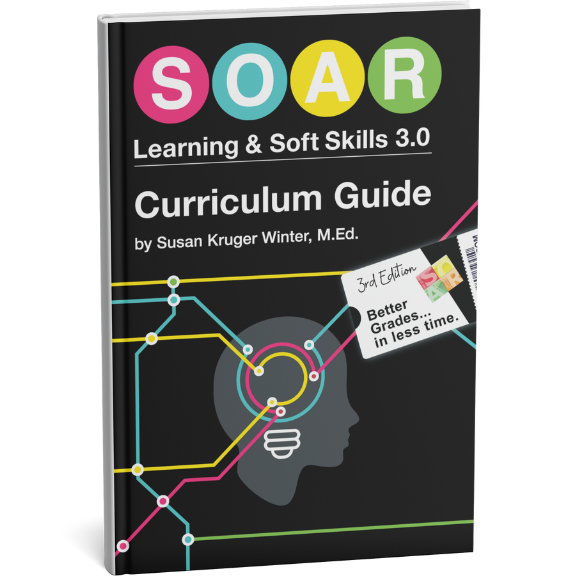Shifting Out of Low-Gear Learning
“My son doesn’t remember what he reads in a textbook.”
“My daughter doesn’t pay attention well in class.”
“She doesn’t take good notes.”
“He doesn’t know how to study for tests.”
All of these situations are problems with learning…learning in a conventional school setting, at least. Most students find each of these tasks boring and laborious…and they will find few adults who could honestly argue with them! There is not much that we can do to change a students’ interest level towards any given topic, but with a little bit of strategy and an efficient plan for tackling these learning tasks, students will find them much less laborious and, as a result, will find learning a little less boring.
There are two underlying causes for these problems. The first is that students tend to view each task in isolation and make the process of completing each assignment or preparing for each quiz and test into a time-consuming and dreadful procedure.
Very few students really understand that paying attention in class during the day may actually save them a lot of time on their homework later that night. Or that paying attention while doing their homework may actually help them study for their quiz at the end of the week. Or finally, that studying for that quiz is actually another step towards studying for the chapter test. Instead, they “reinvent the wheel” with each task.
A second and more significant cause for these learning problems is that students lack *strategy.* Most students have no understanding that learning can be strategic. National and state-mandated curriculum focuses almost exclusively on content; students are loaded down with tons of content, but they are not taught how to access it, organize it, and make sense of it.
Teachers are typically not taught or trained on how to teach learning and soft skills and they are so bogged down with mandated curriculum that they typically don’t have time to think twice about it. Consequently, most of our students just assume that there is no other way to tackle homework or studying than the traditional approach to rehearsing, rereading, and boring themselves to death!
Why Is This Happening?
Students are stuck in “low-gear learning”. There is a famous “learning pyramid” that is taught in most basic education and psychology classes. It is called “Bloom’s Taxonomy of Thinking” and it is pictured here:

With simple strategies, students can easily climb out of the low levels of learning and into “high-gear” learning!
This taxonomy is an illustration of the different levels of thinking in which the human brain can function. The most basic level is listed on the bottom, the most complex on top. The more we can engage our brains in higher levels of thinking, the more we can learn…in a shorter amount of time. Think about two cars…one driving 20 miles down a side-street. The other driving 20 miles down a freeway. Which car will reach its destination faster? Which car is working more efficiently?
The car on the freeway is obviously going to drive the 20 miles faster than the car on the side-street because it can travel at a faster rate of speed and will likely have far fewer stops and interruptions along the way. The car on the freeway will be able to drive in a higher gear, brake less, work more efficiently, and burn less fuel than the car that is slowly trudging along on a side-street. Our brains work the same way.
Unfortunately, however, students are rarely taught how to access the high levels of thinking (those highlighted in red at the top of the chart) and engage in a higher gear. They spend all of their time on school work stuck on those painfully slow side-streets…in “low-gear learning.”
What Can Be Done About it?
The first thing we can do is challenge students to start viewing each learning task as one piece of a much larger puzzle. If students simply adopted the awareness that every lecture, activity, assignment, and quiz was a building block towards the next step, they would immediately save hours of time.
Secondly, students need to learn strategies for “high-gear learning.” One way they can access higher levels of thinking is to learn how to strategically ask questions. Questioning helps students dramatically improve their reading comprehension, which enables them to pay better attention in class, which then enables them to complete homework more quickly, which then allows them to be successful on quizzes and tests.
Every step along the way can be completed with significantly less effort, because they’ve been learning all along…in “high gear.”
This progression does not require hours and hours of training. It only requires a small amount of time to learn how to use questions when reading, sitting in class, doing homework, or studying. When students learn how to approach all of these tasks in a “higher gear,” they will learn so much more…in so much less time!
-Susan Kruger
EB 050217
Six Steps
Conquer the Chaos
Get Our Free Guide & Information on...
 How to Organize & Motivate Students for Success
How to Organize & Motivate Students for Success
"*" indicates required fields
Get Our FREE Curriculum Guide!
The SOAR® Curriculum
The most critical learning, organizing, and communication skills needed for school. Learn more here.
Who’s Using SOAR®?
SOAR® Guarantee
Click here to learn more.




